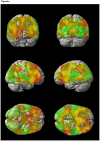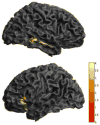Proactive and reactive control during emotional interference and its relationship to trait anxiety
- PMID: 22960116
- PMCID: PMC3541031
- DOI: 10.1016/j.brainres.2012.08.045
Proactive and reactive control during emotional interference and its relationship to trait anxiety
Abstract
In classic Stroop paradigms, increasing the proportion of control-demanding incongruent trials results in strategic adjustments in behavior and implementation of cognitive control processes. We manipulated expectancy for incongruent trials in an emotional facial Stroop task to investigate the behavioral and neural effects of proportion manipulation in a cognitively demanding task with emotional stimuli. Subjects performed a high expectancy (HE) task (65% incongruent trials) and a low expectancy (LE) task (35% incongruent trials) during functional magnetic resonance imaging (fMRI). As in standard Stroop tasks, behavioral interference was reduced in the emotional facial Stroop HE task compared to the LE task. Functional MRI data revealed a switch in cognitive control strategy, from a reactive, event-related activation of a medial and lateral cognitive control network and right amygdala in the LE task to a proactive, sustained activation of right dorsolateral prefrontal cortex (DLPFC) in the HE task. Higher trait anxiety was associated with impairment (slower response time and decreased accuracy) as well as reduced activity in left ventrolateral prefrontal cortex, anterior insula, and orbitofrontal cortex in the HE task on high conflict trials with task-irrelevant emotional information, suggesting that individual differences in anxiety may be associated with expectancy-related strategic control adjustments, particularly when emotional stimuli must be ignored.
Copyright © 2012 Elsevier B.V. All rights reserved.
Conflict of interest statement
Conflict of interest: None declared.
Figures











Similar articles
-
Turning down the heat: Neural mechanisms of cognitive control for inhibiting task-irrelevant emotional information during adolescence.Neuropsychologia. 2019 Mar 4;125:93-108. doi: 10.1016/j.neuropsychologia.2018.12.006. Epub 2019 Jan 4. Neuropsychologia. 2019. PMID: 30615898 Free PMC article.
-
Neurocognitive mechanisms of affective conflict adaptation: An event related fMRI study.Prog Brain Res. 2019;247:149-167. doi: 10.1016/bs.pbr.2019.04.002. Epub 2019 May 8. Prog Brain Res. 2019. PMID: 31196432
-
Adding fear to conflict: a general purpose cognitive control network is modulated by trait anxiety.Cogn Affect Behav Neurosci. 2010 Sep;10(3):357-71. doi: 10.3758/CABN.10.3.357. Cogn Affect Behav Neurosci. 2010. PMID: 20805537
-
Neurobiological correlates of cognitions in fear and anxiety: a cognitive-neurobiological information-processing model.Cogn Emot. 2012;26(2):282-99. doi: 10.1080/02699931.2011.579414. Epub 2011 Aug 1. Cogn Emot. 2012. PMID: 21806384 Free PMC article. Review.
-
Success versus failure in cognitive control: Meta-analytic evidence from neuroimaging studies on error processing.Neurosci Biobehav Rev. 2024 Jan;156:105468. doi: 10.1016/j.neubiorev.2023.105468. Epub 2023 Nov 17. Neurosci Biobehav Rev. 2024. PMID: 37979735 Free PMC article. Review.
Cited by
-
Effects of tolcapone and bromocriptine on cognitive stability and flexibility.Psychopharmacology (Berl). 2018 Apr;235(4):1295-1305. doi: 10.1007/s00213-018-4845-4. Epub 2018 Feb 9. Psychopharmacology (Berl). 2018. PMID: 29427081 Free PMC article. Clinical Trial.
-
Differential Impact of Emotion on Semantic Processing of Abstract and Concrete Words: ERP and fMRI Evidence.Sci Rep. 2019 Oct 8;9(1):14439. doi: 10.1038/s41598-019-50755-3. Sci Rep. 2019. PMID: 31594966 Free PMC article.
-
The impact of pandemic-related worry on cognitive functioning and risk-taking.PLoS One. 2021 Nov 18;16(11):e0260061. doi: 10.1371/journal.pone.0260061. eCollection 2021. PLoS One. 2021. PMID: 34793534 Free PMC article.
-
Comparing neural substrates of emotional vs. non-emotional conflict modulation by global control context.Front Hum Neurosci. 2014 Feb 13;8:66. doi: 10.3389/fnhum.2014.00066. eCollection 2014. Front Hum Neurosci. 2014. PMID: 24592229 Free PMC article.
-
The Effect of Aging on the Dynamics of Reactive and Proactive Cognitive Control of Response Interference.Front Psychol. 2016 Nov 1;7:1640. doi: 10.3389/fpsyg.2016.01640. eCollection 2016. Front Psychol. 2016. PMID: 27847482 Free PMC article.
References
-
- Badre D, Wagner AD. Frontal lobe mechanisms that resolve proactive interference. Cereb Cortex. 2005;15(12):2003–2012. - PubMed
-
- Bar Haim Y, Lamy D, Pergamin L, Bakermans-Kranenburg MJ, van IMH. Threat-related attentional bias in anxious and nonanxious individuals: a meta-analytic study. Psychol Bull. 2007;133(1):1–24. - PubMed
-
- Bishop S, Duncan J, Brett M, Lawrence AD. Prefrontal cortical function and anxiety: controlling attention to threat-related stimuli. Nat Neurosci. 2004;7(2):184–188. - PubMed
-
- Botvinick M, Nystrom LE, Fissell K, Carter CS, Cohen JD. Conflict monitoring versus selection-for-action in anterior cingulate cortex. Nature. 1999;402(6758):179–181. - PubMed
-
- Botvinick MM, Braver TS, Barch DM, Carter CS, Cohen JD. Conflict monitoring and cognitive control. Psychol Rev. 2001;108(3):624–652. - PubMed
Publication types
MeSH terms
Grants and funding
LinkOut - more resources
Full Text Sources
Medical
Research Materials

